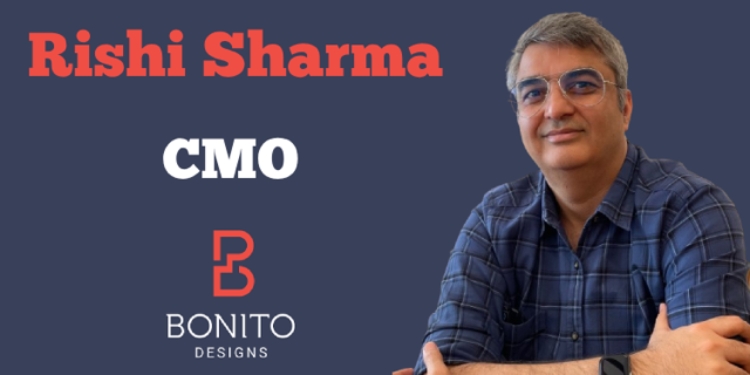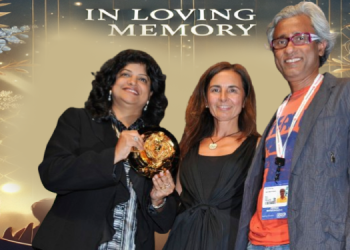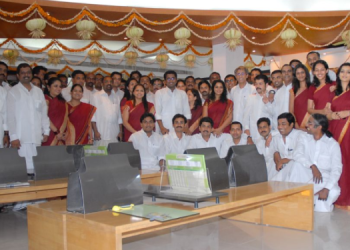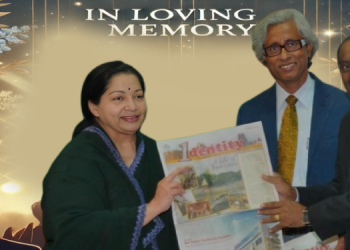Bonito Designs is a home interior brand. It offers homes for its customers. Bonito uses a ‘no catalogue’ approach to bring freshness to all the homes they design. The company which entered Mumbai last year runs four experience centers and has delivered homes spanning across 5 mn sqft to date. Backed by Tomorrow Capital, Bonito plans to launch operations in Pune, Hyderabad, NCR and Chennai. The brand has also once again collaborated with design luminaries, Gauri Khan and Manish Malhotra to unveil a transformative concept ‘World Designs’.
Medianews4u.com caught up with Bonito Designs CMO Rishi Sharma He has managed a spectrum of brands ranging from corporates to start-ups. With exposure to varying business trajectories and budgets, he has developed insights into the changes marketing can swiftly implement to enhance relevance, garner respect, and achieve superior results.
Q. Can you run through your journey being CMO?
My journey has been quite an adventure! Transitioning from advertising agencies to corporate giants like Samsung and Aditya Birla Group and then diving into the world of startups has provided me with a rich tapestry of experiences.
The role of CMO has transformed significantly during my tenure. What was once primarily about branding is now a multifaceted position encompassing growth strategies, customer experience, and brand building. We’ve moved beyond simply broadcasting messages to leveraging data, understanding customer behaviour, and crafting personalised experiences that drive growth while maintaining brand integrity.
The days of simply putting out ads and hoping for the best are long gone. Now, it’s about leveraging data, understanding customer behaviour, and crafting personalised experiences to drive growth while maintaining brand integrity.
The constant balancing act between generating leads, measuring ROI, and executing impactful branding initiatives keeps me on my toes. It’s no longer just about creating awareness; it’s about driving meaningful engagement and, ultimately, conversions. With the proliferation of digital channels and the ever-expanding array of marketing mediums, choosing the right platforms to reach our audience has become a strategic decision in itself.
In today’s fast-paced world, customer loyalty seems to be more elusive than ever. With endless options at their fingertips, consumers are more discerning and demanding than before. Building and nurturing lasting relationships with customers has become paramount, requiring a deep understanding of their needs, preferences, and pain points.
And let’s not forget about the relentless competition. With new players entering the market and existing ones constantly innovating, staying ahead of the curve is no easy feat. It’s a testament to my skills and adaptability that I’ve successfully navigated these challenges throughout my career.

I’ve embraced these complexities, continually seeking new ways to drive growth, enhance customer experience, and elevate our brand. It’s been an exciting journey, and I look forward to the challenges and opportunities that lie ahead in this ever-evolving landscape of marketing.
Q. Are you focussing across the country for growth, or is the strategy focussed on the Metros?
Our current growth strategy is primarily focused on metropolitan areas. This is a deliberate choice given that our product category is still nascent, with just over 10% market penetration, even in metros. We believe it’s crucial to establish a strong foothold and drive acceptance in these urban centres first, where early adopters are more concentrated, and infrastructure support is robust.
Focussing our resources on metros can optimise our marketing spend, gather critical consumer insights, and refine our product and strategies before expanding. While we recognise the long-term potential of non-metro markets, ensuring strong adoption in metros will pave the way for a more successful nationwide rollout in the future.
Q. Does the unorganised nature of the sector pose a challenge when it comes to growth?
The unorganised nature of our sector does present challenges, but it also offers opportunities. Our marketing efforts require significant investment as we need to educate customers about the advantages of choosing organised players over unorganised ones. This education process, while costly, is crucial for our growth. Interestingly, the prevalence of the unorganised sector actually motivates startups like ours to develop more structured, efficient approaches.
We can differentiate ourselves and drive growth by highlighting the benefits of our organised solutions—such as reliability, quality assurance, and customer support. So, while the unorganised sector poses initial hurdles, it also provides the impetus for innovation and improvement, ultimately contributing to our long-term success.
Q. When confronted with a large volume of data, CMOs often struggle to put it to good use. How do you tackle this situation of a humongous amount of data?
When confronted with vast volumes of data, my approach is to leverage technology and strategic prioritisation to transform this potential challenge into a competitive advantage. I rely on Data Management Platforms (DMPs) to aggregate, organise, and analyse data from diverse sources such as customer interactions, website visits, and transactions. This allows us to gain comprehensive insights into consumer behaviour and preferences.
These insights then feed into our Demand-Side Platforms (DSPs), where we leverage our enriched first-party data for highly targeted advertising campaigns. DSPs enable precise audience segmentation and real-time bidding, ensuring our marketing efforts are directed towards the most relevant audience segments, thereby maximising ROI.
The key is not just collecting data but asking the right questions about that data. We avoid getting lost in the noise by focusing on metrics that align with our business objectives. This strategic use of data allows us to navigate the challenges of data overload, driving targeted, impactful campaigns that resonate with our audience while maintaining compliance and building trust.
Q. In the design category, what are the do’s and don’ts when it comes to marketing?
In the design category, effective marketing involves adhering to several key principles while avoiding common pitfalls. First and foremost, it’s crucial to show what you deliver and never over-promise and under-deliver. Transparency and honesty in communication build trust and foster long-term relationships. Given that home is a very sensitive place, marketing strategies should avoid gimmicks and instead approach home design with genuine respect and authenticity. Value-driven marketing that reflects the personal and emotional significance of home spaces resonates more with clients.
Managing online reputation (ORM) is another critical aspect. Engage actively with customer testimonials, showing respect and appreciation for their feedback. Highlight positive reviews and professionally address negative comments to build credibility. Since the design category is digital-first, investing in a robust digital presence is essential. Optimise search engines and maintain active, appealing profiles on social media platforms like Instagram and Google to capture and retain customer interest effectively.
It’s also vital to create an experience-led design strategy, understanding that home design is heavily dependent on consumer preferences and involvement. All strategies should focus on providing the customer with a personalised and immersive experience.
Conversely, avoiding overpromising and under delivering is essential, as this can severely damage credibility and trust. Gimmicky marketing tactics should be steered clear of, as they can undermine your brand’s integrity and lead to long-term trust issues. Ignoring customer feedback and testimonials is another pitfall to avoid, as mishandling reviews can negatively impact your reputation.
Neglecting your digital presence and relying solely on traditional marketing methods can result in missed opportunities and reduced visibility in a digital-first market. Additionally, overlooking the high customer acquisition cost can lead to significant losses if the customer journey is not managed effectively. Lastly, remember that home design is inherently collaborative and experience-driven; the customer’s role is central to the process.
By following these principles and avoiding common mistakes, you can create effective, trust-building marketing strategies that resonate with customers and drive success in the design category.

Q. What role does influencer marketing play in driving conversations?
Influencer marketing is pivotal in driving conversations by leveraging authentic voices to overcome customer scepticism in our industry. Authentic endorsements and real customer experiences showcased in your marketing efforts build trust and sway decisions. Furthermore, the high customer acquisition cost necessitates careful management of the customer journey from initial interest to conversion. Using the right tools, content, and campaigns ensures a seamless and engaging experience, minimising lead loss and drops.
Q. Is traditional media like print and TV also used?
We use traditional media selectively, based on its effectiveness for our design category. TV advertising is generally avoided due to its high cost and broad reach, which is often misaligned with our city-centric, geographically focused market. Design tastes and demands vary significantly between markets, especially for home-related products, making national TV campaigns less effective unless a brand has a presence in over 22 cities.
Instead, we lean more towards targeted traditional media. FM radio, for instance, has proven more effective than TV for maintaining high recall in ongoing campaigns. For local area marketing, we prefer local print ads over mainline advertisements. This Below The Line (BTL) media mix is crucial for achieving Top Of Mind Awareness (TOMA) in our specific target areas. Our strategy, therefore, focuses on traditional media that allows for geographical targeting and localisation rather than broad-reach platforms like national TV.
Q. Could you talk about how your deeply personalised approach gives a leg up over the competition?
Our deeply personalised approach is a key differentiator in the market. We recognise that customers seek designs reflecting their unique personality and lifestyle, not generic catalogues or templates. By prioritising an intensive customer briefing and requirement-gathering phase, we ensure that each design is tailored to the client’s specific needs and preferences. This meticulous attention to individual details not only leads to higher customer satisfaction but also results in solid word-of-mouth referrals. Our approach transforms clients into brand advocates, giving us a significant edge over competitors who may rely on more standardised solutions.
Q. Do you use AR, VR in digital ad campaigns to create an immersive experience?
Not at present. While we recognise the potential of AR and VR technologies, their application in our digital ad campaigns is still premature for our brand and target market. Our current focus is refining and optimising more established digital channels that have proven effective with our audience. We’re monitoring developments in AR and VR closely, and when we see signals of increased adoption and ROI in our sector, we’ll be ready to integrate these immersive technologies into our marketing strategy.

Q. What role is AI playing in your company?
AI enhances our customers’ design experience by powering our personalised recommendation engine. When customers select furniture or decorative items, our AI and machine learning algorithms analyse their choices and their overall design theme. The system then suggests complementary items based on popular selections by customers with similar preferences. This AI-driven approach streamlines the selection process and introduces customers to products they might not have considered, improving satisfaction and average order value.

















